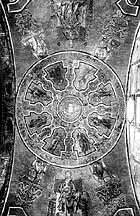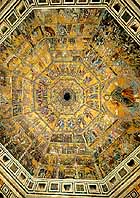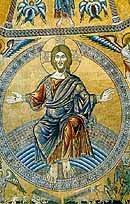
The mosaics in the apse
Excusez nous mais cette page n'est pas été encore traduite en Français
The "scarsella", the rectangular apse or chapel that contains the altar, was the first part of the interior of the Baptistery to be lined with mosaics. After it had been transformed from a semicircular to a rectangular shape in 1202, the apse was decorated from 1225-28 by Fra Jacopo (for this reason also known as "della Scarsella"); he was the first artist to come from the newly founded Franciscan Order and was called to work in the Baptistery by the Consuls of the Guild of Calimala, the patrons of the Opera di San Giovanni. The monk created mosaics of the Baptist and of the Virgin and Child enthroned with the mystic lamb, Prophets and Patriarchs in the centre. The next mosaics to be carried out were those in the cupola (from 1266-70 onwards). The view from the square gives no real idea of the actual size of the pyramid-shaped roof divided into eight segments. It is really a double construction: the outer roof rises up from the drum (the third floor of the marble facing) while the internal vault starts lower down, from the second floor, where the women's gallery is situated. This method of superimposed roofing, similar to the Roman Pantheon, was carefully studied by Brunelleschi for his project of the cupola of the Cathedral.

The mosaics in the cupola
The internal pyramid-like vault is decorated all over with extremely beautiful mosaics of the Last Judgement and Stories of John the Baptist, Joseph and the Genesis. The composition is placed against a gold background in the six concentric divisions that cut horizontally across the eight segments (the same solution was also used later on for the fresco of the Last Judgement by Vasari in the cupola of the Cathedral). The episodes shown in five of the segments are separated vertically from the others by narrow painted columns, repeating the same kind of division into three used for the marble revestment.

Christ in Judgement
The mosaics are set in the following pattern. The central area at the top around the opening of the lantern contains ornamental elements; this is followed by the image of Christ surrounded by Seraphim and angelic hierarchies; the third cycle narrates stories from the Genesis, while the fourth contains stories of Joseph, the fifth stories of Christ, and the last stories of the Baptist. The area of the apse is dominated by the gigantic figure of Christ in Judgement (over eight metres high) accompanied, in the three fascias above, by the angels announcing the Last Judgement, the Virgin Mary, John the Baptist and the Apostles, the Resurrection of the Dead and the division of the Blessed from the Damned, with a terrifying representation of Hell that certainly inspired Dante when he wrote his Divine Comedy.

Coppo di Marcovaldo, Hell
The entire cycle was completed midway between the 13th and 14th centuries, and in only a few decades, by Venetian mosaicists (real specialists in this craft and the direct heirs of the Byzantine tradition) from designs and cartoons provided by some of the finest artists in Florence at the time. The Maestro della Maddalena, Meliore di Jacopo, the Maestro del San Francesco Bardi, Gaddo Gaddi and, above all, Coppo di Marcovaldo and his pupil Cimabue, founder of the new "Italian" style of painting, all worked here. Coppo's powerful personality produced the figure of Christ and the portrayal of Hell, while Cimabue apparently carried out the drawings for the stories of Joseph. As a whole, the mosaic represents a collective display of Florentine painting before the arrival of Giotto while signs of the new monumental style are already recognizeable in the plastic importance of the various groups.
